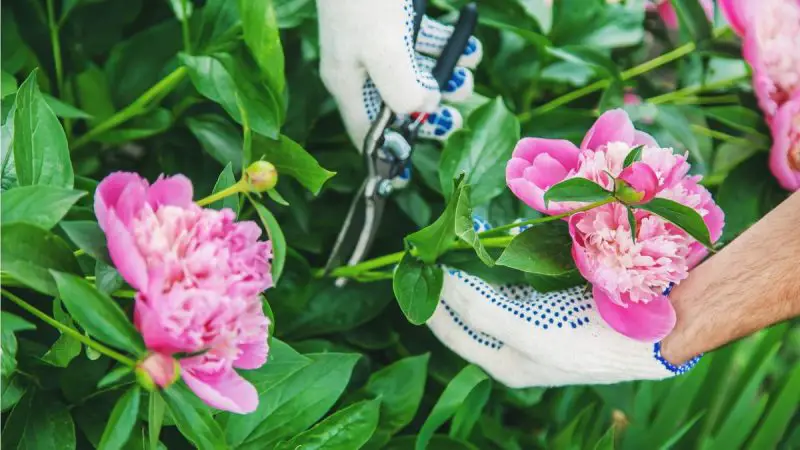Peonies are among the most cherished perennial flowers in gardens around the world, known for their luxurious blooms, long lifespan, and minimal maintenance. But even the toughest perennials benefit from seasonal care, and one of the most common questions gardeners ask is, “When do you cut peonies down to keep them thriving?” The answer lies in understanding the plant’s growth cycle, seasonal behavior, and how proper timing affects long-term performance. Cutting peonies down at the wrong time can weaken their structure, expose them to disease, or reduce their vigor for the next blooming season.
Timing is everything when it comes to perennial maintenance, especially with plants like peonies that die back to the ground each year. Knowing when to cut them back helps ensure your plants store enough energy in their roots to produce abundant flowers the following spring. It also prevents unwanted pests and diseases from lingering through the winter months. Many gardeners believe they should trim as soon as the blooms fade, but this could do more harm than good. Instead, it’s important to let the foliage remain until it naturally begins to wither in the fall.
This article explores the ideal time to cut down peonies for different climates, provides insight into why seasonal timing matters, and explains how pruning impacts peony health and performance year after year. With a deeper understanding of these beautiful plants, gardeners can make informed choices that support both short-term beauty and long-term vitality.
Understanding the Peony Growth Cycle

To determine the best time for cutting down peonies, it’s important to understand their natural growth cycle. Peonies emerge in early spring with red-tinted shoots that quickly turn into dense green foliage. By late spring to early summer, they produce large, often fragrant blooms that can last for a few weeks depending on weather conditions and variety. After the flowers fade, the plant continues to photosynthesize through its leaves, storing energy in the underground crown and roots for the next season.
Even after blooming, the leaves remain lush and green throughout summer. This post-bloom phase is vital to the plant’s future performance. Cutting the plant down too early would deprive it of the opportunity to recharge and rebuild its internal resources. By late summer and early fall, the leaves begin to yellow and decline as the plant naturally prepares for dormancy. This is when cutting back becomes appropriate.
Understanding this life cycle reveals why patience is essential. Allowing peonies to complete their seasonal progression before trimming ensures a stronger, more productive plant in future years. It also mirrors the rhythms of nature, which is always the best guide in gardening.
Why Cutting Back Peonies Is Necessary
While peonies are considered low-maintenance, they still benefit from some annual attention—particularly when it comes to cutting back dead foliage. Leaving peony stems and leaves to rot in place over winter can invite fungal diseases such as botrytis blight. This common issue thrives in decaying organic matter and may reappear in spring if not properly managed. Removing dead foliage in the fall reduces the risk of infections and promotes a cleaner, healthier garden.
Another reason to cut back peonies is aesthetic. By the time late fall arrives, the once-beautiful foliage has usually turned yellow or brown and may have collapsed to the ground. Removing it tidies the garden and prepares it for winter mulching or other seasonal tasks. It also allows gardeners to assess the health of the plant’s crown and surrounding area, ensuring there are no signs of rot or pest activity.
Cutting back also sets the stage for spring emergence. With last year’s stems and leaves cleared away, new shoots can grow unimpeded. This promotes better air circulation, more efficient photosynthesis, and a stronger start to the season. When combined with proper soil preparation and spacing, fall trimming helps maximize peony vitality and flowering potential.
The Best Time to Cut Peonies Down
The most widely recommended time to cut back peonies is in the late fall, typically after the first frost. At this point, the foliage has completed its job of nourishing the roots and has begun to naturally die back. The visual signs are clear—leaves turn yellow, brown, or black, and stems begin to sag toward the ground. This signals that the plant has entered dormancy and is ready for winter rest.
Timing may vary depending on your region. In colder northern climates, frost comes earlier, so cutting back peonies might happen as early as late September or early October. In milder southern zones, this process may not be necessary until late October or even November. Regardless of your location, the key indicator is the state of the foliage. Gardeners should wait until the leaves and stems have visibly deteriorated before removing them.
By aligning pruning with the plant’s natural dormancy, you allow the peony to maximize its energy reserves and reduce stress. This promotes a more vigorous return in spring, with healthier shoots and larger blooms. Trying to cut back too early may lead to incomplete nutrient storage and less impressive performance the following year.
How Peonies Respond to Early or Late Pruning
Cutting peonies down too early—before the foliage yellows and wilts—can interrupt the process of energy storage. Peonies rely on their green leaves through the summer to produce and store carbohydrates in the root system. These carbohydrates are essential for new growth and flower production the following year. Early pruning may not immediately kill the plant, but over time it can lead to weaker stems, fewer flowers, and reduced overall vigor.
On the other hand, waiting too long to cut back dead foliage can also cause problems. Decaying peony leaves and stems can harbor pests and diseases, especially in wet or humid environments. By mid to late winter, any remaining dead plant material becomes a breeding ground for pathogens that can infect next year’s shoots. Delaying pruning past early winter reduces the benefits of sanitation and risks contaminating fresh growth as it emerges.
The optimal window is a balance between allowing the plant to fully enter dormancy and removing dead material before it becomes a liability. This usually falls between late October and mid-November, depending on local climate and the plant’s condition. With close observation, gardeners can time their pruning for maximum effectiveness.
Climate Zones and Regional Differences
Your USDA hardiness zone has a significant impact on when and how to cut back peonies. In colder zones, such as Zones 3 through 6, peonies experience early frosts and enter dormancy quickly. The foliage typically dies back in early to mid-autumn, allowing gardeners to clean up their plants before the onset of heavy snow. In these zones, early fall cleanup is not only practical but often necessary to avoid overwintering diseases.
In warmer zones, like Zones 7 through 9, peonies may hold onto their foliage longer. They might not experience a killing frost until much later in the season, and in some cases, the leaves remain green into November. In these climates, patience is even more important. Waiting until the leaves naturally decline ensures that the plant completes its full growing cycle, even if the gardener must wait a bit longer to cut them back.
Regardless of location, watching the plant itself is more reliable than relying solely on the calendar. Seasonal fluctuations, rainfall, and temperature changes all affect plant behavior. Observing leaf color, stem strength, and overall appearance is the best guide to determine when it’s time to act.
The Role of Frost in Peony Pruning
Frost plays a critical role in signaling dormancy in herbaceous perennials like peonies. A light frost causes the outer layers of plant cells to freeze and rupture, leading to discoloration and decline in foliage. For peonies, this process begins the shutdown of active metabolism and helps transition the plant into dormancy. Gardeners often wait until after the first hard frost to begin cutting back because it confirms the plant has finished its seasonal work.
After the frost has blackened or wilted the leaves, you can safely remove them without compromising the root system. At this stage, nutrients have already migrated downward and been stored in the roots. Removing the foliage at this point won’t hinder the plant’s ability to regrow in spring and actually helps protect it from diseases that thrive in decomposing vegetation.
While one frost may not immediately kill all foliage, repeated frosts usually speed up the process. Monitoring nighttime temperatures and watching for signs of damage helps determine the best timing. For gardeners aiming for clean, healthy regrowth, letting nature take the lead is the most effective strategy.
Cutting Technique and Aftercare
Once it’s time to cut back peonies, the process itself is fairly simple. Using clean, sharp pruners, the stems should be cut close to the ground—ideally about an inch above the soil surface. Cutting too high can leave unnecessary stubs that rot, while cutting too low may damage the crown. If done correctly, this removes the entire stem and leaf structure while preserving the healthy root system below.
After cutting, it’s important to remove all debris from around the plant. Dead leaves and stems should be discarded, not composted, especially if there were any signs of fungal disease. This prevents pathogens from overwintering in the soil and infecting the plant in spring. Some gardeners choose to apply a thin mulch layer after pruning to protect the crown through winter, especially in colder zones.
Peonies typically do not require additional feeding or fertilization after pruning. Their root systems are storing energy and are best left undisturbed. In spring, when shoots reappear, fresh mulch and a light application of fertilizer can support new growth.
Common Mistakes to Avoid
One of the most frequent errors gardeners make is cutting peonies down too soon, particularly right after blooming. While it’s understandable to want a tidy garden, this practice weakens the plant and may reduce flower production the following year. Another common mistake is leaving decaying foliage over the winter, which increases the risk of disease.
Over-mulching is another issue. While a light mulch layer can protect roots in harsh winters, piling mulch too high over the crown can suffocate the plant or encourage rot. It’s important to keep mulch levels moderate and ensure good air circulation around the base of the plant.
Some gardeners confuse cutting down with dividing, which are two different practices. Peonies can be divided, but this should only be done in fall every 10 to 15 years and with mature, overcrowded plants. Routine cutting down should happen annually and not disturb the root ball.
Long-Term Benefits of Proper Pruning
Consistent, well-timed pruning supports the overall health and productivity of peonies. When done properly, cutting back in the fall helps prevent disease, encourages clean spring growth, and improves flowering performance. Over time, gardeners will notice fuller plants, stronger stems, and more abundant blooms as a result of annual care.
Pruning also offers the chance to inspect plants closely and identify any developing problems. Spotting rot, fungal issues, or insect activity early allows for quick intervention and long-term plant protection. It’s also an opportunity to refresh soil, adjust mulch, and improve spacing if needed.
The reward for these efforts comes in spring, when new red shoots emerge from the soil and promise another season of stunning blooms. With each passing year, properly maintained peonies become stronger, more resilient, and more rewarding to grow.
FAQ About Cutting Down Peonies
When do you cut peonies down for the season?
The best time to cut peonies down is in late fall, after the foliage has yellowed or blackened from the first frost. At this stage, the plant has stored enough energy in its roots for next year’s growth.
Can I cut peonies back right after they bloom?
No, cutting peonies right after blooming can weaken the plant. The foliage needs to remain intact during summer to photosynthesize and recharge the roots.
What happens if I don’t cut peonies down in the fall?
If you leave peony foliage over winter, it may harbor pests or fungal diseases like botrytis. This can affect the plant’s health and performance in the next growing season.
Do peonies grow back if cut down too early?
They may survive, but early cutting reduces stored energy and can lead to fewer blooms or weaker stems in the following spring. Always wait until foliage dies naturally.
Should I mulch peonies after cutting them back?
A thin layer of mulch can protect the crown in colder regions, but don’t overdo it. Keep mulch a few inches away from the crown to avoid rot.
Conclusion
Peonies are hardy, beautiful perennials that reward gardeners year after year with minimal care—but timing matters. Knowing when to cut peonies down is one of the most important aspects of their seasonal maintenance. By allowing the foliage to remain until it naturally dies back in late fall, you ensure that the plant stores all the energy it needs for the next bloom cycle.
Cutting at the right time helps prevent disease, strengthens root development, and sets the stage for more vibrant flowers in spring. Whether you’re in a warm southern garden or facing early frost in the north, let the peony’s foliage guide your timing—not the calendar. With the right pruning habits, your peonies will continue to thrive and impress season after season.






